Gall
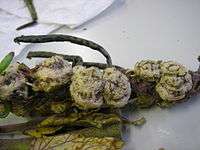


Galls or cecidia are a kind of swelling growth on the external tissues of plants or animals. Plant galls are abnormal outgrowths[1] of plant tissues, similar to benign tumors or warts in animals. They can be caused by various parasites, from fungi and bacteria, to insects and mites. Plant galls are often highly organized structures and because of this the cause of the gall can often be determined without the actual agent being identified. This applies particularly to some insect and mite plant galls. The study of plant galls is known as cecidology.
In human pathology, a gall is a raised sore on the skin, usually caused by chafing or rubbing.[2]
Causes of plant galls
Insects and mites
Insect galls are the highly distinctive plant structures formed by some herbivorous insects as their own microhabitats. They are plant tissue which is controlled by the insect. Galls act as both the habitat and food source for the maker of the gall. The interior of a gall can contain edible nutritious starch and other tissues. Some galls act as "physiologic sinks", concentrating resources in the gall from the surrounding plant parts.[3] Galls may also provide the insect with physical protection from predators.[4][5]
Insect galls are usually induced by chemicals injected by the larvae or the adults of the insects into the plants, and possibly mechanical damage. After the galls are formed, the larvae develop inside until fully grown, when they leave. In order to form galls, the insects must seize the time when plant cell division occurs quickly: the growing season, usually spring in temperate climates, but which is extended in the tropics.
The meristems, where plant cell division occurs, are the usual sites of galls, though insect galls can be found on other parts of the plant, such as the leaves, stalks, branches, buds, roots, and even flowers and fruits. Gall-inducing insects are usually species-specific and sometimes tissue-specific on the plants they gall.
Inductor insects
Gall-inducing insects include gall wasps, gall midges, gall flies, Agromyzidae aphids (such as Melaphis chinensis, Pemphigus spyrothecae, and Pemphigus betae), scale insects, and psyllids. Various galls produced by insects and mites are listed below:
- Ash Flower Gall: This gall is caused by a small mite that causes irregular distortion of male flowers. The galls are initially green, then dry and turn brown.
- Ash Midrib Gall: Normally 1/2 inch to 1 inch long, these galls are succulent and have thick walls. A small cavity within each gall contains one or more small maggots, the larval stages of very small flies called midges. Female midges lay their eggs in very young leaflets during early spring. Gall formation begins soon after the eggs are laid. Specifics of the biology of this insect are not known. The galls probably do not harm tree health.
- Elm Cockscomb Gall: These distinct galls, caused by an aphid, are about 1" long and about 1/4 inch high. The irregular edge of the gall and its red color at maturity account for the common name. The galls dry, harden and turn brown as they age. Aphids may be seen through a slit-like opening in the underside of the gall. This insect has a complex life cycle -- it forms galls on elm in early summer, then feeds on grass roots later in the summer. The galls apparently do not cause significant harm to the tree.
- Hackberry Leaf Gall: This gall is caused by a small (1/10 inch long) aphid-like insect with sucking mouthparts called a jumping plant louse. The adults spend the winter under bark crevices and can invade houses in large numbers in the fall. Females lay eggs over a long period of time beginning when leaves begin to unfold from the buds in the spring. Feeding by the nymphs that hatch from these eggs causes abnormal plant growth that forms a pouch.The psyllids remain inside the galIs until they emerge as adults in late summer to early fall. There is one generation each year. Heavy infestations can result in premature leaf drop which over a series of years may affect tree health.
- Honeylocust Pod Gall :This gall is caused by a small fly (midge). The Sunburst cultivar appears to be very susceptible to this pest. infested leaves have globular or pod-like distortions that contain one to several small maggots (1/4" long). Infestations begin when females lay eggs in young leaflets. There are five or more generations each year.Infested leaves often drop prematurely and repeated damage can kill small branches. New shoots develop at the base of dead twigs. As a result, the natural shape of the tree may be lost.
- Oak gall: see Oak apple
- Petiole and Stipule Galls: Thick globe-like galls can develop on leaf petioles and stems. Many of these are caused by insects called phylloxerans (pronounced "fill OX erans"), which are very similar to aphids. The hard, woody galls may remain on the tree for several years. Usually, there is one generation each year and the insects over winter on the tree in the egg stage.
- Willow Shoot Galls: These swellings on shoots, twigs, or leaf petioles, may be caused by small flies (midges) or small wasps (sawflies).The gall increases in size as long as the immature stages are active. They cause no significant injury.The infestation may be reduced by pruning and destroying the galled areas before the adult insect emerges, usually in late summer.
- Witchhazel Gall: This gall is caused by an aphid that passes the winter in eggs laid on twigs of the plant. Feeding by the aphid causes the formation of conical galls on the upper side of the leaf. Each gall, produced by single aphid, later becomes filled with offspring. Mature aphids with wings leave the galls in late spring and early summer and fly to birch. After several generations there, the insects return to witch hazel to lay the eggs that survive the winter. No galls are formed on birch.
Fungi
Many rust fungi induce gall formation, including Western gall rust, which infects a variety of pine trees and cedar-apple rust. Galls are often seen in Millettia pinnata leaves and fruits. Leaf galls appear like tiny clubs; however, flower galls are globose. Exobasidium often induces spectacular galls on its hosts.
It is worth noting that the fungus Ustilago esculenta associated with Zizania latifolia, a wild rice, produces an edible gall highly valued as a food source in the Zhejiang and Jiangsu provinces of China.[6]
Bacteria and viruses
Agrobacterium tumefaciens and Pseudomonas savastanoi are examples of gall-causing bacteria. Gall forming Virus was found on rice plants in central Thailand in 1979 and named rice gall dwarf. Symptoms consisted of gall formation along leaf blades and sheaths, dark green discoloration, twisted leaf tips and reduced numbers of tillers. Some plants died in the glasshouse in later stages of infection. The causal agent was transmitted by Nephotettix nigropictus after an incubation of 2 weeks. Polyhedral particles of 65 nm diameter in the cytoplasm of phloem cells were always associated with the disease. No serologic relationship was found between this virus and that of rice dwarf.
Nematodes
Nematodes are microscopic worms that live in the soil. Some nematodes (Meloidogyne species or root-knot nematodes) cause galls on the roots of susceptible plants. The galls are small, individual and beadlike in some hosts. In other plant species galls may be massive accumulations of fleshy tissue more than an inch in diameter. Some ectoparasitic nematodes (nematodes that live outside the plant in the soil), such as sting and stubby-root nematodes, may cause root tips to swell.Nitrogen-fixing bacteria (Rhizobium species) cause swellings on the roots of most legumes (such as clover, peas and beans). These swellings, called nodules, are easily distinguished from root-knot galls by differences in how they are attached to the root and their contents. Nodules are loosely attached to the root, while root-knot galls originate from infection at the center of the root, so they are an integral part of the root. In addition, fresh Rhizobium nodules have a milky pink-to-brown liquid inside them, while root-knot galls have firmer tissues and contain female root-knot nematodes (creamy white beads less than 1/32 inch in diameter) inside the gall tissues.
Other plants
Mistletoe can form galls on its hosts.
Uses
Galls are rich in resins and tannic acid and have been used in the manufacture of permanent inks (such as iron gall ink) and astringent ointments, in dyeing, and in tanning. A high-quality ink has long been made from the Aleppo gall, found on oaks in the Middle East. The Talmud, ([7]) records using gallnuts as part of the tanning process as well as a dye-base for ink.
The larvae in galls are useful for a survival food and fishing bait; see the Indigenous Australian foods Bush coconut and Mulga apple. Nutgalls also produce purpurogallin.
The gall of Rhus chinensis, Galla chinensi, has long been considered to possess many medicinal properties.[8]
Gallery
 Gall on a Maple leaf
Gall on a Maple leaf Rose bedeguar gall on a wild rose in summer.
Rose bedeguar gall on a wild rose in summer.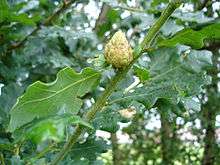 Oak artichoke gall (Andricus fecundator)
Oak artichoke gall (Andricus fecundator)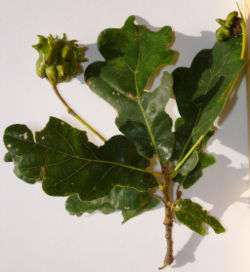 Knopper gall (Andricus quercuscalicis)
Knopper gall (Andricus quercuscalicis)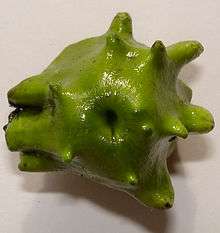 Knopper gall (Andricus quercuscalicis)
Knopper gall (Andricus quercuscalicis) Neuroterus albipes forma laeviusculus
Neuroterus albipes forma laeviusculus Eucalyptus leaf gall
Eucalyptus leaf gall Andricus kollari oak gall
Andricus kollari oak gall- Cola-nut galls (Andricus lignicola) on Pedunculate Oak

- Oak marble galls, one with a Gall fly exit hole and another with Phoma gallorum fungal attack.
- Red-pea gall (Cynips divisa) on Pedunculate oak.
Sectioned gall showing central 'cell' and inquiline chamber; exit-hole and a possibly parasitised stunted gall specimen. - Pineapple gall on Sitka Spruce caused by Adelges abietis.
- Developing Pineapple pseudocone galls on Norway Spruce
 Goldenrod Gall
Goldenrod Gall- An Oak tree with multiple Oak apples.
 Oak Apples on an oak tree.
Oak Apples on an oak tree.- Lime nail galls (Eriophyes tiliae tiliae)
 Gall of peach tree leaves, found at Beijing
Gall of peach tree leaves, found at Beijing- Andricus kollari gall
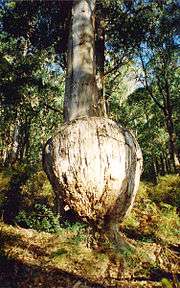
- Gall attack on Eucalyptus due to Leptocybe invasa at Acharya N. G. Ranga Agricultural University
See also
- Forest pathology
- Burl
- Bush coconut
- Chirosia betuleti
- Mulga apple
- Oak apple
- Oak marble gall
- Knopper gall
- Oak artichoke gall
- Rose bedeguar gall
- Pineapple gall
- Cola-nut gall
- Neuroterus quercusbaccarum - common spangle and currant galls
- Witch's broom
Footnotes
- ↑ Merriam-Webster Online Dictionary, accessed Nov. 16, 2007 ("an abnormal outgrowth of plant tissue usually due to insect or mite parasites or fungi and sometimes forming an important source of tannin")
- ↑ medical-dictionary.thefreedictionary.com
- ↑ Larson, K. C., and T. G. Whitham. 1991. Manipulation of food resources by a gall-forming aphid: the physiology of sink-source interactions. Oecologia 88, P.15 – 21.
- ↑ Weis, A. E., and A. Kapelinski. 1994. Variable selection on Eurosta’s gall size. II. A path analysis of the ecological factors behind selection. Evolution 48, P.734 – 745.
- ↑ Graham N. Stone and Karsten Schonrogge (2003) The adaptive significance of insect gall morphology. TRENDS in Ecology and Evolution 18(10):512-522
- ↑ Terrell, E.E. and L.R. Batra. Zizania latifolia and Ustilago esculenta, a grass-fungus association. Economic Botany 36(3):274-285.
- ↑ Bavli, tractate Gittin:19a
- ↑ Zhang J, Li L, Kim SH, Hagerman AE, Lü J. 2009. "Anti-cancer, anti-diabetic and other pharmacologic and biological activities of penta-galloyl-glucose." Pharm Res 26: 2066–2080.
Further reading
- Blanche, Rosalind (2012). Life in a Gall: The Biology and Ecology of Insects that Live in Plant Galls. Collingwood, Vic.: CSIRO Publishing. ISBN 064310643X.
- Redfern, Margaret (2011). Plant Galls. London: Collins. ISBN 0002201445.
- Russo, Ron (2007). Field Guide to Plant Galls of California and Other Western States. Berkeley, Calif.: Univ. of California Press. ISBN 9780520248854.
External links
| Wikimedia Commons has media related to Galls. |
- British Plant Gall Society
- A Field Guide to Plant Galls of the North East U.S.
- To Be or Not To Be a Gall: The Story of Strange Growths on Plants
- Insect Galls. Brandeis University
- Galls in Goldenrod, (Solidago)
- "Common oak galls". University of Kentucky Entomology.
